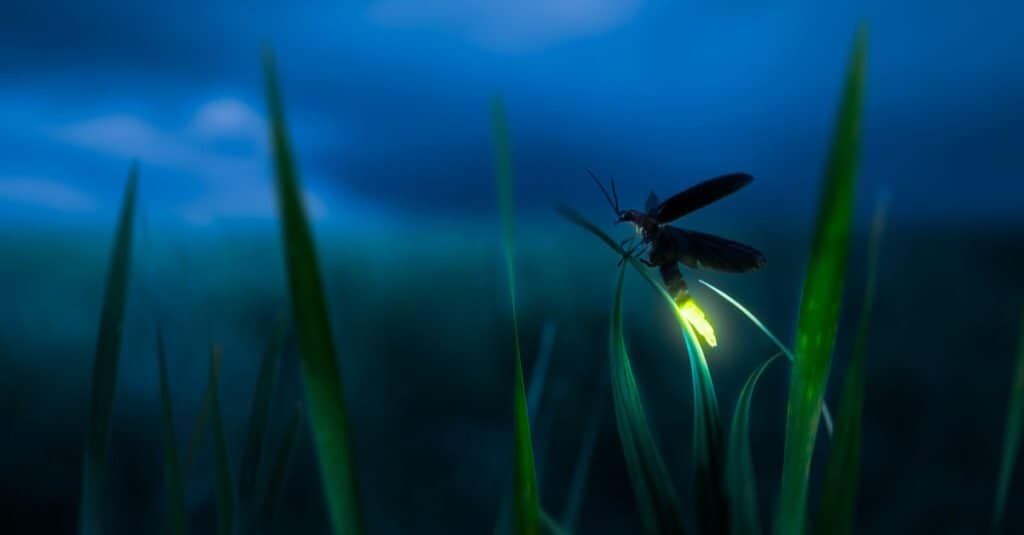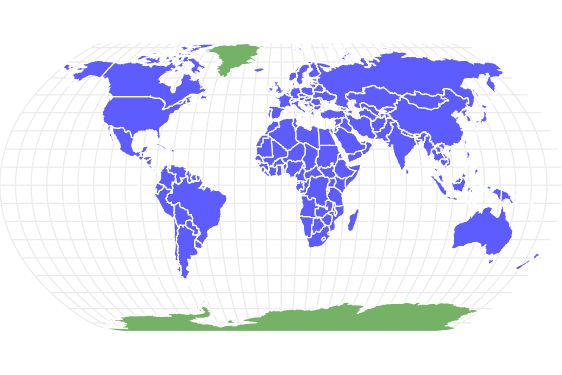Firefly
Lampyridae
The firefly produces some of the most efficient light in the world
Advertisement
Firefly Scientific Classification
Read our Complete Guide to Classification of Animals.
Firefly Conservation Status
Firefly Facts
- Prey
- Insects, snails, worms, nectar, and pollen
- Name Of Young
- Larvae
- Group Behavior
- Solitary
- Fun Fact
- The firefly produces some of the most efficient light in the world
- Biggest Threat
- Habitat loss and light pollution
- Most Distinctive Feature
- The glowing abdomen
- Other Name(s)
- Lightning bug or glowworm
- Gestation Period
- 3-4 weeks
- Litter Size
- up to 100 eggs
- Habitat
- Forests, fields, meadows, and other habitats
- Predators
- Birds, mammals, insects, and more
- Diet
- Omnivore
- Type
- insect
- Common Name
- firefly
- Number Of Species
- 2003
View all of the Firefly images!

“The firefly is a family of light-emitting insects. They produce light through a chemical reaction of oxygen, calcium, energy, and a light-emitting molecule called luciferin.“
Fireflies are some of the most popular and beloved insects in the world. Basically, all firefly larvae can produce light, but many species lose this ability in adulthood. Only a small number of firefly species light up the night sky with their bioluminescent ability.
Bioluminescence means they can produce their light via a chemical reaction. Nearly all of the energy in this reaction is transformed into light, which makes fireflies one of the most efficient sources of light in the world. This article will cover some interesting facts about the habitat, diet, lifespan, and appearance of these glowing insects.
Species, Types, and Scientific Names

©Suzanne Tucker/Shutterstock.com
The scientific name for the firefly family is Lampyridae. The name is derived from the Latin term lampyris, which roughly translates to mean glowworm (even though glowworm refers exclusively to a firefly larva or wingless adult). There are many different types of fireflies, encompassing some 2,000 documented species. About 150 of them live in the United States and Canada alone.
Here are some of the most common subspecies:
- Lampyris noctiluca
- Luciola
- Nipponoluciola cruciata
- Luciola lateralis
- Common eastern firefly
- Photuris
- Lampyris
- Pteroptyx
- Lampyrinae
- Luciolinae
- Pyractomena
- Phausis reticulata
- Winter firefly
- Abscondita
- Aspisoma
- Inflata
- Microphotus
- Pleotomus
- Cyphonocerinae
- Amydetinae
- Psilocladinae
- Brachylampis
Evolution and Origins
Fireflies, an ancient group of insects, trace their origins back over 100 million years to a common ancestor of the two main lineages. However, fireflies are not the sole luminous insects in nature. There are also certain click beetles that possess the fascinating ability of bioluminescence, emitting light in a similar manner to fireflies.
Based on our research findings, we suggest that during the mid-Cretaceous forest, the common ancestor of fireflies underwent an evolutionary process.
This process involved the trade-off of its original function, which was most likely an aposematic warning display against nocturnal predation. As a result of this trade-off, the fireflies developed green light luciferase as a new adaptation.
Appearance

©Fer Gregory/Shutterstock.com
The firefly is a type of soft-bodied beetle that generally ranges widely in size and appearance. Most species are characterized by long, cylindrical bodies, often sporting black or brown colors with yellow or red markings.
They have a pair of wings hidden beneath the hard shell cover, but in some species, the female is completely flightless and resembles the larval form. One such flightless female holds the record for the largest type of firefly in the world. It can easily reach the size of a human palm. However, most species are no more than one or two centimeters long.
Fireflies create light for all kinds of different reasons: some are looking for mates, others are attempting to lure in prey, and yet others just want to warn away predators. The reasons can change depending on species and life stages. The cold light (which produces very little heat) is normally emitted from an organ near the end of the abdomen.
Colors can come in yellow, orange, or green, and each species generally has its unique flashing pattern, which can be synchronized to communicate in groups. One of the most interesting facts is that many species lose their bioluminescence as an adult; they are active during the day and use chemical pheromones instead of light to communicate with potential mates.
Before the firefly insect transforms into an adult, it passes through a few different life stages. The larva is the most common and longest-living of these stages. It has a long, segmented body, simple eyes, and no wings. The upper segments look a bit like overlapping plates; they are long and flat, extending over the sides of the bug. When it’s ready to transform, the larva forms a large cocoon that encases the entire body.
Habitat
Lightning bugs are present all over the world except for the most extreme environments. They can be found most often populating forests, fields, meadows, and grasslands.
Adults are most active in the summer months and spend the winter in a state of reduced activity. Many firefly insects come out at night, but non-glowing species are active during the day.
Firefly populations are very healthy and widespread all over the globe. However, there is some evidence to suggest that firefly populations are on the decline. The cause might be related to light pollution, habitat loss, and pesticide use.
Once an area has been cleared of its natural habitat, that firefly population may be gone for good. It does not simply move to a new area.
Diet
The firefly does most of its feeding as a larva. When it transforms into an adult, its feeding patterns completely change. However, there are some facts about the firefly’s feeding behavior we still don’t understand.
For a complete analysis of what fireflies eat, make sure to read our comprehensive guide ‘What Do Fireflies Eat?‘
What eats the firefly?
Fireflies are preyed upon by numerous other insects, reptiles, birds, and small mammals. However, most firefly species leave a very bad taste in the mouth. Some can even cause temporary sickness when consumed. This will usually dissuade most predators from attacking them.
What does the firefly eat?
Firefly larvae are completely carnivorous. They feed on snails, worms, and other insects. Some of them can inject a digestive substance directly into the prey that liquefies their organs. By the time they reach adulthood, they switch to an herbivorous lifestyle, feeding on the nectar and pollen; they may even help fertilize plants by spreading pollen from one flower to another.
However, there are notable exceptions. A few types of so-called “femme fatale fireflies” mimic the signaling pattern of another firefly species in an attempt to lure the male and then consume him. Some adult fireflies do not eat at all before they die.
Prevention
Fireflies do not generally cause harm to anyone; it’s best to just leave them alone. However, if the fireflies are bothering you in some manner, then you should remove them from your property in an ethical manner by capturing and then releasing them. Sprays or insecticides should never be used.
View all 91 animals that start with FFirefly FAQs (Frequently Asked Questions)
Are fireflies dangerous?
Fireflies do not generally pose any danger to people. They also do not cause any damage to crops, buildings, or other property.
How many legs does the firefly have?
The lightning bug has six legs like all other types of insects.
How do you identify the firefly?
Adult fireflies are easy to identify. They usually come out at night during the summer and produce a strong glowing light. They are characterized by a long cylindrical body, a soft shell, and a pair of wings. Some species do not glow, but they otherwise look like normal firefly insects.
What insect looks similar to a firefly?
The firefly-mimicking longhorn beetle has evolved to resemble the firefly in size, shape, and colors, including the yellow-colored segments at the end of the abdomen (which do not actually glow). By mimicking the firefly, it hopes to fool predators into believing it is not very tasty. Fireflies also look somewhat similar to the closely related glowing click beetles.
What type of insect is a firefly?
The firefly is actually a type of beetle. The closest living relatives are click beetles and soldier beetles.
Why do fireflies glow?
Fireflies use their bioluminescence to attract a mate or lure prey. The glowing may also serve as a potential warning to predators.
Do fireflies bite or sting?
They do not generally bite or sting people.
Where can fireflies be found?
Fireflies are found most often in forests, meadows, fields, and grasslands at night (and some during the day). They’ve also adapted to life near homes, parks, and gardens.
How do you capture a firefly?
If you’re interested in seeing a firefly up close, then you can capture one in a glass jar with holes in the lid and damp paper towels at the bottom to keep the air humid. Just remember to release them quickly afterward so they can continue to reproduce.
What is the life cycle of a firefly?
The firefly has a four-stage life cycle: the eggs, the larva, the pupa, and the adult. After a female lays up to 100 bioluminescent eggs in moist soil (like much or leaf litter) or vegetation, the larvae will usually hatch three to four weeks later and spend most of the summer consuming food. They will repeatedly molt their exoskeleton and become progressively larger. Many species burrow underground or find a hole or crevice to wait out the first winter (and sometimes a second-winter). They will emerge again in the spring and either continue to feed or begin their transformation into an adult.
When it’s large enough to become a pupa, the firefly will construct a mud chamber in the soil or attach itself to a piece of tree bark and hang upside down by its hind legs. Its body is slowly broken down and then reassembled by a special group of transformative cells. The pupa stage generally lasts for a few weeks. After the firefly transforms into an adult, its main purpose is to seek out another mate. They do very little feeding, and some species do not eat at all. The adult form may only have a lifespan of a few months.
How long do fireflies live?
The average firefly lifespan is roughly 1 year in the wild. Fireflies typically only live for about two months as adults, but throughout their whole life cycle, it accounts for about a year or two.
Thank you for reading! Have some feedback for us? Contact the AZ Animals editorial team.
Sources
- Smithsonian magazine / Accessed January 1, 2022
- The National Wildlife Federation / Accessed January 1, 2022
- ThoughtCo. / Accessed January 1, 2022


















